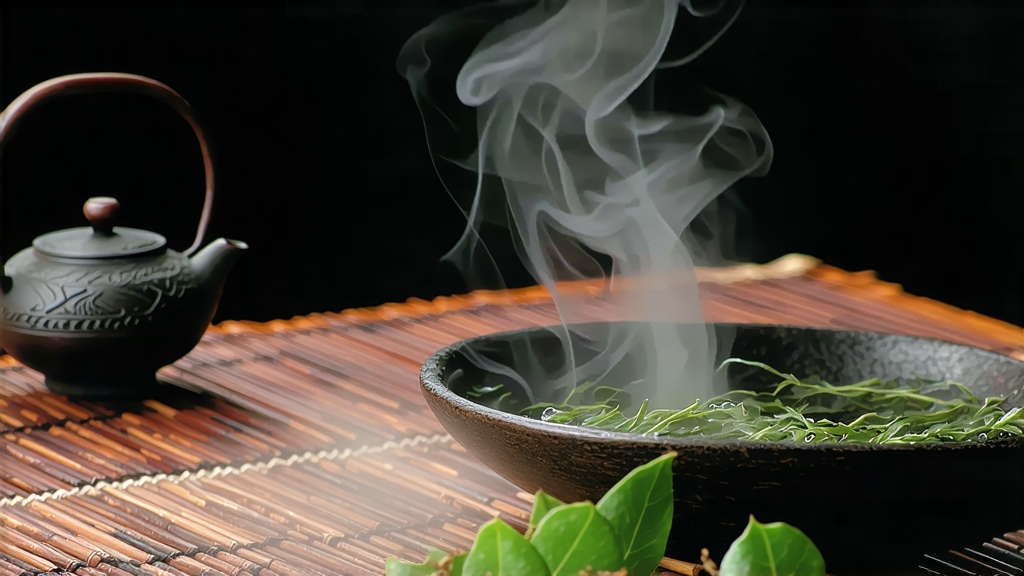
Tucked beneath the humid folds of southern China’s Guangxi Zhuang Autonomous Region, Liupu tea (often spelled Liu Bao) is the quiet, bass-note member of the dark tea chorus. While Pu-erh from Yunnan commands global fame, Liupu has spent four centuries maturing in bamboo baskets, pressed into fragrant bricks, and absorbing the subtropical soul of its homeland. To the international palate it offers a bridge between the forest floor and the spice market, between fermented cacao and damp camphor wood—an accessible yet endlessly unfolding profile that rewards patient brewing and even more patient cellaring.
Historical roots
The name itself is a geographical signature: Liupu was the old river port (pu) through which baskets of dark tea traveled from the mountains of Wuzhou down the Xun River to Guangzhou and, eventually, the tea-hungry markets of Hong Kong and Southeast Asia. Records from the Qing-era Daoguang reign (1821-1850) already list “Liupu cha” as a distinct commodity, taxed and traded alongside porcelain and medicinal herbs. Sampans carried it south; coolies loaded it onto British clippers bound for Calcutta and Singapore. There the tea met Indian spices, Malaysian pandan, and the maritime climate of the Straits Settlements, beginning a post-voyage secondary fermentation that delighted dockside tea masters. Thus, long before “aged tea” became a boutique concept, Liupu was already a globe-trotter, quietly cross-cultivating flavor.
Terroir and leaf
Guangxi’s low-latitude hills trap monsoon clouds between karst outcrops, creating year-round humidity above 80 % and mean temperatures of 22 °C—ideal conditions for the slow microbial choreography that defines dark tea. The indigenous cultivar is the Da Ye Zhong (large-leaf) variety, a close cousin to Yunnan’s daye but acclimatized to richer lateritic soils laced with iron oxide. Farmers pick one bud plus the third or fourth leaf, seeking the thicker cell walls that withstand the forthcoming wet-pile fermentation without collapsing into mulch. These mature leaves also carry higher starch reserves, later converted into the mellow sweetness that balances Liupu’s trademark earthiness.
Crafting the darkness
Liupu production follows the classic dark tea sequence—kill-green, rolling, wet piling, drying, and compression—but with micro-variations that create its unique aromatic code.
- Sha Qing (kill-green): Leaves are pan-fired at 280 °C for three to four minutes, enough to denature polyphenol oxidase yet preserve leaf integrity. The goal is a flexible, jade-green strip that smells of grilled edamame rather than the biscuity note of pan-fired green tea.
- Rolling: A 25-minute low-pressure roll bruises the edges while keeping the midrib intact, encouraging future microbial entry points without excessive sap release.
- Wo Dui (wet piling): The signature step. Piles of 1.5 tonnes are built on bamboo mats, sprayed to 35 % moisture, and covered with jute sacks. Internal temperature is monitored daily; when it hits 55 °C workers “fan” the pile, inserting bamboo poles to vent steam and reintroduce oxygen. Over 25-30 days mesophilic fungi such as Aspergillus niger and yeasts like Cyberlindnera proliferate, metabolizing caffeine and catechins into theobromine and gallic acid—compounds responsible for Liupu’s smooth mouthfeel and chocolate-like bitterness.
- Drying: Instead of Yunnan’s sun-drying, Liupu is charcoal-baked in a raised bamboo barn for 12 hours at 45 °C. The gentle heat halts microbial activity while adding a whisper of smoked caramel.
- Compression & wrapping: The semi-dry leaf is steamed for 30 seconds, pressed into 500 g bricks or 30 kg baskets lined with bamboo leaf and palm bark. These natural wrappers act as micro-vessels, allowing minute oxygen exchange while imparting a grassy, almost sake-like top note that becomes more pronounced with age.
The vintage curve
Fresh Liupu is surprisingly drinkable: low astringency, a hint of raw cacao, and a sweet potato finish. Yet the magic lies in post-compression aging. At five years the liquor turns from amber to deep mahogany; woody aromatics appear. After fifteen years camphor and dried longan dominate, while the caffeine level drops by half, making